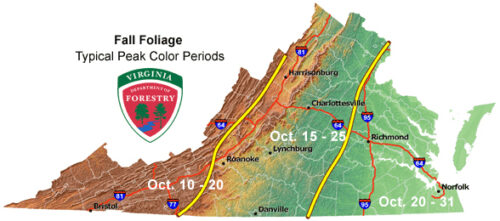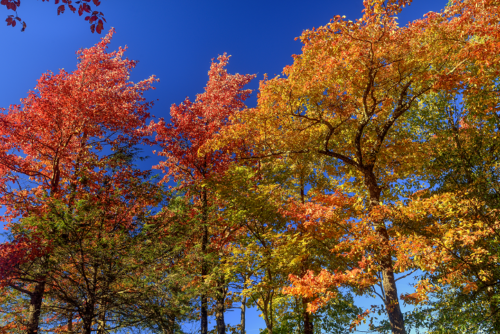Fall Foliage in Virginia
 Virginia is diverse in landscape, from the highest mountains to the Eastern Shore. The variety in landscape and elevation provides a long fall foliage season, starting earliest in the higher elevations and moving eastward. Fall colors generally peak sometime between October 10 and October 31; however, these dates can vary from year to year, based on factors such as temperature and rainfall.
Virginia is diverse in landscape, from the highest mountains to the Eastern Shore. The variety in landscape and elevation provides a long fall foliage season, starting earliest in the higher elevations and moving eastward. Fall colors generally peak sometime between October 10 and October 31; however, these dates can vary from year to year, based on factors such as temperature and rainfall.
Virginia’s many species of deciduous trees create an interesting mix of autumn colors. Here are some colors you can expect from some of our most common species:
| Tree | Color | Timing in Fall Season |
| Black Gum | Bright red | Early |
| Dogwood | Red to maroon | Early |
| Tulip-poplar | Yellow | Early |
| Red Maple | Orange to brilliant scarlet | Middle |
| Sugar Maple | Bright orange | Middle |
| Beech | Yellow to orange | Middle |
| Hickory | Gold | Middle |
| Oaks | Deep red, amber, russet | Late |

General timing of fall foliage season, in years of typical rainfall and temperatures

Week of Oct. 10-17, 2022
Weekly Fall Foliage Report
October 18 —
Much of Virginia has now experienced at least one overnight frost. Chilly nights and bright sunny days are helping to develop excellent colors, especially reds, across the central, northern, and western portions of the state.
Our highest elevation forests, such as the Grayson Highlands, the High Knob area of Wise and Scott counties, and parts of the Alleghenies, are now past their peak, but still lovely. Lower elevations, including most of the Blue Ridge and Cumberland Plateau, will begin to peak this weekend. Many trees and shrubs species are contributing to the fall color show this week. Watch for deep red dogwoods, bright red Virginia creeper, sumac, black gum, and red maple; orange sassafras and sugar maple; and the standout gold of hickories. Many other trees, shrubs, and vines add shades of yellow. Oaks have begun to don their garnet, amber, and russet colors, although many remain mostly green. Watch for them to develop color in the next week or so.
- Flag Rock Recreation Area near Norton (photo by Wayne Browning)
- Pickem Mountain, Wise County (photo by Wayne Browning)
Fall Foliage Resources
- Fall Foliage Report – (800)424-LOVE (begins mid-late September each year)
- Blue Ridge Parkway – (828)298-0398 (press “3”)
- George Washington and Jefferson National Forest
- Smoky Mountains Fall Foliage Prediction Map
- All things Fall In Virginia from the Virginia Tourism Corporation
- Find a state forest to view fall color
- Prince William Forest Park is an oasis of natural beauty and human history located just south of Washington, DC.
Fall Foliage Driving Tours
Try our VDOF-recommended Fall Foliage Driving Tours.
Why Leaves Change Color
- Chlorophyll gives leaves their familiar green color.
- Carotenoids produce yellow, orange, and brown colors.
- Anthocyanins produce red and purple colors and are the same pigments that give color to fruits like blueberries and cherries.
Both chlorophyll and carotenoids are present in the leaf cells throughout the growing season. During this time, chlorophyll is produced and leaves appear green. As days get shorter, chlorophyll production slows and eventually stops. With the green color no longer visible, the yellow carotenoids are revealed. During autumn, bright light and excess plant sugars produce red anthocyanins within leaf cells.

























